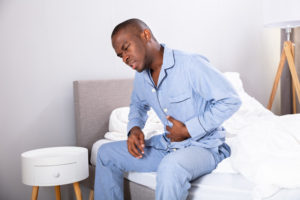Last time you dropped in, we were discussing what gallstones were and how they could be causing stomach pain. This week, we are going to further this discussion by sharing signs of gallbladder dysfunction. Also, we would like to share the signs of gallstones.
Are gallstones causing my abdominal pain?:
According to the American College of Gastroenterology, gallstones are often accidentally detected while investigating other health issues. However, we do not want that to be the case for you. Read further to discover signs that you may have gallstones.
If you notice any of the symptoms we are going to discuss today, seek out medical attention at Gastroenterology Consultants of Central Florida where you will meet Dr. Keith Moore and Dr. Aniq Shaikh at 10800 Dylan Loren Circle Suite 102.
Abdominal pain:
 Naturally, the first sign of gallstones we are going to share is abdominal pain. A typical liver cannot be felt with your fingers. However, it is located under the lower edge of your right ribcage.
Naturally, the first sign of gallstones we are going to share is abdominal pain. A typical liver cannot be felt with your fingers. However, it is located under the lower edge of your right ribcage.
You may have an enlarged liver though if your doctor can feel it during an examination according to Healthline. The size and weight of your liver grows naturally with age. Moving on, sporadic recurrence of dull pain near the liver is the most common sign of gallstones.
Physicians say the pain often strikes after eating and can last hours before it resolves. Pain is often experienced in the upper right abdomen, but it can also travel to the upper back. It can also reach the center of the abdomen.
Pain after eating:
 Pain followed after meals is the next sign of gallstones. It may not happen after every meal, or it may happen, unfortunately, after every single meal. How daunting. A gallbladder attack, or biliary colic pain, can last for an hour and up to several hours.
Pain followed after meals is the next sign of gallstones. It may not happen after every meal, or it may happen, unfortunately, after every single meal. How daunting. A gallbladder attack, or biliary colic pain, can last for an hour and up to several hours.
As we have mentioned a few times, this pain is most likely to be triggered after a large, fatty meal. Chronic pain may persist for hours. But this may also suggest there are way more serious gallbladder issues, so it is best to play it safe and get examined at our Orlando office.
Doctors also note that the timing of the pain is important as pain typically comes within hours of eating. If you experience pain while you are eating or immediately after eating, then this may be something other than gallbladder disease.
Can’t get any relief?:
If either the biliary or chronic pain you are experiencing is not relieved with an over the counter pain reliever, it may be an indication you have a gallbladder issue. When people do not experience relief after changing positions, passing gas, or bowel movements, these are also indications of gallbladder disease. Specifically, these two signs often help narrow down stomach pains and blame the gallbladder.
Jaundice as a sign of gallbladder dysfunction:
Jaundice is most commonly known is households for babies appearing yellowish. The whites of their eyes may be a little yellow along with their skin. Dark urine and pale colored school are signs of jaundice.
Jaundice in adults is a sign of liver trouble. It is also a sign of gallbladder problems in adults. The gallbladder releases bile. The bile goes into the small intestine through a tube called the cystic duct. This connects to the bile duct.
You see, jaundice occurs when these ducts are obstructed, or blocked. The blockage can build up bile and increase the concentration of bilirubin. Bilirubin is a yellowish substance. Is it all making sense now?
Next week, we are going to continue this gallbladder talk. We hope you stop by next time! Have a great week.
Staff Writer
